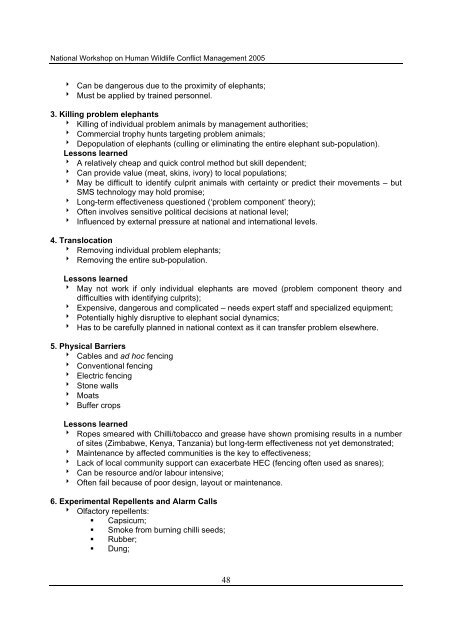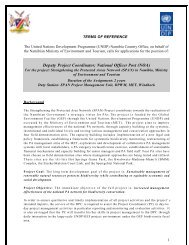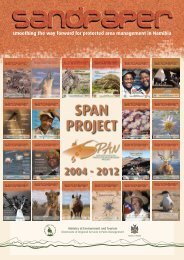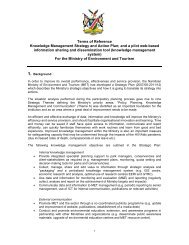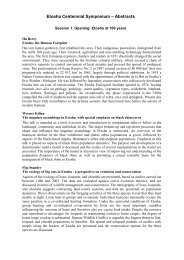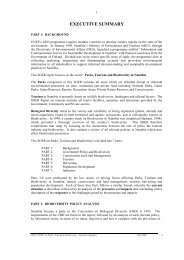HWCM - Ministry of Environment and Tourism
HWCM - Ministry of Environment and Tourism
HWCM - Ministry of Environment and Tourism
Create successful ePaper yourself
Turn your PDF publications into a flip-book with our unique Google optimized e-Paper software.
National Workshop on Human Wildlife Conflict Management 2005<br />
8 Can be dangerous due to the proximity <strong>of</strong> elephants;<br />
8 Must be applied by trained personnel.<br />
3. Killing problem elephants<br />
8 Killing <strong>of</strong> individual problem animals by management authorities;<br />
8 Commercial trophy hunts targeting problem animals;<br />
8 Depopulation <strong>of</strong> elephants (culling or eliminating the entire elephant sub-population).<br />
Lessons learned<br />
8 A relatively cheap <strong>and</strong> quick control method but skill dependent;<br />
8 Can provide value (meat, skins, ivory) to local populations;<br />
8 May be difficult to identify culprit animals with certainty or predict their movements – but<br />
SMS technology may hold promise;<br />
8 Long-term effectiveness questioned (‘problem component’ theory);<br />
8 Often involves sensitive political decisions at national level;<br />
8 Influenced by external pressure at national <strong>and</strong> international levels.<br />
4. Translocation<br />
8 Removing individual problem elephants;<br />
8 Removing the entire sub-population.<br />
Lessons learned<br />
8 May not work if only individual elephants are moved (problem component theory <strong>and</strong><br />
difficulties with identifying culprits);<br />
8 Expensive, dangerous <strong>and</strong> complicated – needs expert staff <strong>and</strong> specialized equipment;<br />
8 Potentially highly disruptive to elephant social dynamics;<br />
8 Has to be carefully planned in national context as it can transfer problem elsewhere.<br />
5. Physical Barriers<br />
8 Cables <strong>and</strong> ad hoc fencing<br />
8 Conventional fencing<br />
8 Electric fencing<br />
8 Stone walls<br />
8 Moats<br />
8 Buffer crops<br />
Lessons learned<br />
8 Ropes smeared with Chilli/tobacco <strong>and</strong> grease have shown promising results in a number<br />
<strong>of</strong> sites (Zimbabwe, Kenya, Tanzania) but long-term effectiveness not yet demonstrated;<br />
8 Maintenance by affected communities is the key to effectiveness;<br />
8 Lack <strong>of</strong> local community support can exacerbate HEC (fencing <strong>of</strong>ten used as snares);<br />
8 Can be resource <strong>and</strong>/or labour intensive;<br />
8 Often fail because <strong>of</strong> poor design, layout or maintenance.<br />
6. Experimental Repellents <strong>and</strong> Alarm Calls<br />
8 Olfactory repellents:<br />
• Capsicum;<br />
• Smoke from burning chilli seeds;<br />
• Rubber;<br />
• Dung;<br />
48


